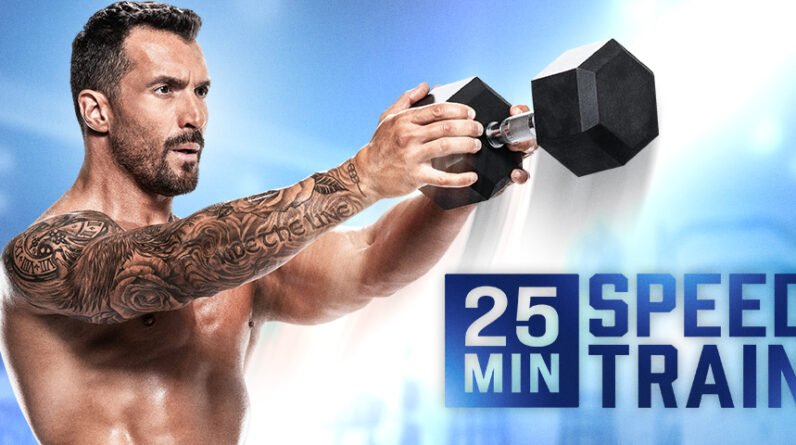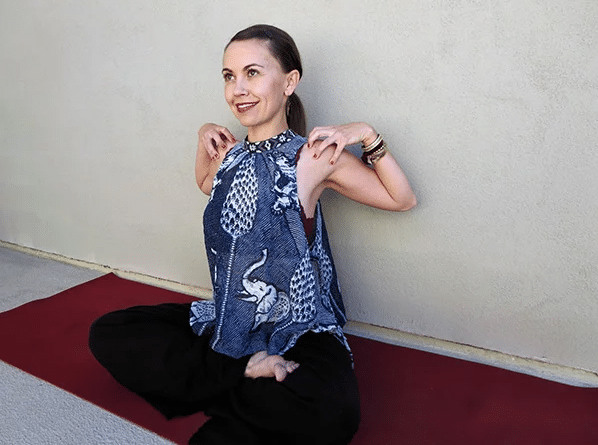
It doesn’t matter which push-up variations you do—they’re all hard. Even enough reps on your knees can make your arms all sorts of sore, and considering that’s one of the easiest options when ranking push-up variations, it’s safe to say your entire body is going to feel like it’s on fire as you move further down the list of upper body exercises.
But before trying anything too challenging, you have to master basic push-ups. Here’s everything you should know before diving into the exercise progressions.
Experts In This Article
- Devan Kline, co-founder and CEO of Burn Boot Camp
- Edward Rush, CEO at ThirdPower Fitness
- Joshua Thomas, fitness trainer at Life Time Summerlin
- Korey Rowe, CPT, trainer at Dogpound
- Maillard Howell, trainer and owner of Dean CrossFit
- Rob Sulaver, co-founder of Rumble Boxing
- Romie Dalal, trainer and boxing coach
- Sarah Brooks, certified trainer, Pilates instructor, and founder of Brooks Pilates
What is a push-up?
When it comes to the exercises commonly seen in bodyweight workouts, the humble push-up is always a staple.
“A push-up is a versatile exercise that engages your entire body, with a primary focus on strengthening the upper body,” Sarah Brooks, CPT, certified trainer and founder of Brooks Pilates, previously told Well+Good.
The exercise starts in a plank position. Then, while keeping a straight line from your head to your heels, you lower your chest to the floor then lift back up to your starting position—all while maintaining core engagement.
What muscles do push-ups work?
Primarily, the muscles worked in push-ups include your chest, anterior deltoids, and triceps, says Rob Sulaver, a Rumble Trainer on Equinox+. “
You’ll also get some solid core engagement,” he says. And to a lesser extent, push-ups work your legs and hips, too. In other words, they provide a full-body workout, and one which, as Sulaver points out, requires no equipment. “You only need your body and gravity, which means you can do them anywhere,” he says.
How to integrate push-up variations into your fitness routine
There are different push-up styles to meet you at every stage of your fitness journey. “They’re scalable from easy to incredibly difficult,” Sulaver says. “Elevating your hands on a wall or countertop is going to make push-ups much easier. Plyometric variations like superman push-ups are extremely difficult.”
Different variations of push-ups offer different outcomes, too. “Depending on the style of push-up you do, you can develop power, strength, or muscular endurance,” Sulaver says. “If you do lots of reps of an easier push-up, you’ll develop endurance. If you do more challenging push-ups, you’ll develop strength. And if you do explosive plyometric style push-ups, you can develop power.”
The next time you’re up for a challenge, work your way through the list of the best push-up variations—many of which you probably haven’t even heard of yet—below. There’s the hand-release push-up that makes grown men in the Army sweat bullets, the half-split push-up Kate Hudson makes look easy (even though it’s definitely not), and the Spiderman push-up that has you scaling the floor like a superhero.
Just don’t move through the list of easiest to hardest push-ups too quickly. Start with the easiest variations and see how many you can do in a row before moving on to more challenging push-up techniques.
“This starting point will help you determine how to best train and what your weak points in a push-up are,” Joshua Thomas, a trainer at Life Time Summerlin, previously told Well+Good. Once you nail one variation, you can move on to the next, building your strength little by little every day.
And while attacking each strength training option, watch out for common form mistakes that can sabotage your efforts. Letting your body sag when you’re working on building upper body strength, for example, is a big one, Sulaver says.
“People commonly drop their chin or hips toward the ground instead of staying strong and engaged throughout the set,” he explains. The trainer also advises paying attention to your elbows to make sure they’re 45 degrees from your midline. “Your torso and arms should make more of an arrow shape than a T shape,” he says.
If you need a little extra strength to avoid these mistakes, add the best exercises to improve push-ups into your fitness routine.
How to warm-up before training with push-up variations
Sure, it’s tempting to just drop down and start pumping out all the different push-up styles below. However, if you want your body to stay pain-free during upper body exercises, adding a proper warm-up into your fitness routine is incredibly important.
According to Devan Kline, CEO and co-founder of Burn Boot Camp, 17 different muscles attach to the scapula (aka the shoulder blade) alone. Because of that, he advises starting any push-up-focused bodyweight workout with mobility exercises that focus on the shoulder blades, wrists, and elbows.
“Where multiple muscles are conjoined, it’s really important to warm them up dynamically,” he previously told Well+Good. “When you strengthen muscles, you contract and shorten them, and if you continue to do that without lengthening—through warmups and stretching—your joints are going to be more susceptible to injury.”
Kline has a series of upper-body mobility exercises he recommends, including “waves and prayers” (which involves interlocking your fingers and rolling waves with your hands, then putting your hands in a prayer position), elbow circles, and a plank protraction. Aside from warming up your muscles and joints before starting your bodyweight workout, you’ll also get added mobility. It’s a win-win.
With those tips in mind, it’s time to up the workout intensity and get started on your push-up challenge. Only one question remains: How far do you think you can get on the scale of easiest to hardest push-ups? Let your journey in building upper body strength begin.
Beginner push-up modifications
Before doing more challenging exercise progressions, you’ll want to start with some push-up variations for beginners. But don’t be fooled: Even though you’re at the beginner push-up difficulty level, these upper body exercises will still make you work up a sweat.
1. Wall push-up
When ranking push-up variations, the wall push-up is certainly the easiest. This incline push-up will start to strengthen all the muscles needed to perform push-ups on the ground. (You can also give soleus push-ups a try, which are basically push-ups for your calf muscles.)
2. Knee push-up
The knee push-up is one of the best push-up variations for beginners. It helps you build up your strength before taking the exercise to the plank position.
3. Pilates ring push-up
A simple modification you can make between knee push-ups and standard push-ups is putting a Pilates ring vertically underneath your chest, which helps support your body so you can stay in a strong plank position during your push-ups.
4. Standard push-up
Before moving onto any harder variations, you have to master the form of the standard push-up: body in a straight line, shoulders over your wrists, and hands shoulder-width apart. (If you want to up the challenge, you can try weighted push-ups, which involve performing regular push-ups with weight on your back.)
Intermediate push-up modifications
Ready for a push-up challenge now that you’ve mastered all the push-up variations for beginners? At the intermediate push-up difficulty level, you’ll find different push-up styles and exercise progressions that really begin building upper body strength.
5. Shoulder tap push-up
Up the workout intensity by adding shoulder taps to regular push-ups. It’s a simple addition, but it starts to put your strength to the test as you’re balancing between arms.
6. T push-up
Next up are T push-ups. The exercise combines three tough moves—a push-up, plank, and side plank—to work your core and shoulders on a deeper level.
7. Triceps push-up
Looking for push-up variations for the back of your arms? Tricep push-ups specifically target the area. Because the focus is shifted to your triceps and less on your chest, like in regular push-ups, they’re a more challenging variation of the standard exercise.
8. Pike push-up
If you think your triceps are already sore, just wait. The pike push-up puts even more weight on your arms and shoulders as you’re performing the exercise, upping the challenge.
9. Plank push-up
This plank-push-up hybrid has you moving from a high plank to a forearm plank with as much control as possible, working your abs, shoulders, arms, and more. (Want to amp things up? Try the Russian push-up, which has you shifting back and forth between a regular push-up and a forearm plank.)
10. Toe tap push-up
This exercise hits strength and cardio at the same time. Between push-ups, you take turns tapping your foot in one quick, swift motion. Talk about working up a sweat.
11. Pseudo planche push-up
Instead of facing your fingers toward your head in standard push-ups, this strength training option involves facing your fingers toward your feet. “The orientation of the fingers pointing toward your feet and sitting farther down your torso places a greater demand on your shoulders and biceps, causing them to work harder,” says Korey Rowe, trainer at Dogpound in New York City.
12. Hand-release push-up
The hand-release push-up is part of the Army Combat Fitness Test, so you know you’re looking at a high level of workout intensity. Instead of simply going up and down, your chest goes all the way down to the ground where you release both bands an inch off the floor. That means there’s no way to cheat—you have to complete a full push-up every time.
13. TRX push-up
TRX push-ups work your upper and lower body at the same time. If you have access to a TRX suspension trainer, you complete the push-up by standing with your knuckles in line with your shoulders, then slowly bend your arms into a push-up position. Next, you straighten them to bring your body back up. You can up the push-up challenge even more by performing the exercise at an angle.
14. Blast-off push-up
This is hands-down one of the best push-up variations. Blast-off push-ups require you to shoot your lower body back into a crouch hover plank-like position between push-ups, and because of the extra coordination and strength it requires, it only takes a few reps before your entire body is feeling the burn.
Advanced push-up variations
Now that you’ve mastered the intermediate push-up techniques, you can officially up your push-up difficulty level to advanced. Just be warned: On a scale of easiest to hardest push-ups, these are going to make your arms all sorts of wobbly.
15. Dive bomber push-up
Dive bomber push-ups are a combination of push-ups and yoga sun salutations, giving you a full-body challenge that doesn’t just involve your core, arms, chest, and back like in the standard exercise. “I think dive bomber push-ups are way harder than traditional push-ups,” says Maillard Howell of Dean CrossFit. “It involves more pushing with the shoulder versus pushing with the chest, like in a traditional push-up. You’re also going to get a lot more hamstring and lower back stretch activation when you do dive bomber push-ups.”
16. Pylo push-up
When doing a pylo push-up, you start in a high plank with your hands on plates or risers, then jump your hands to the floor between the risers to do a standard push-up. Then, you finish by jumping your hands back up to the plates. This strength training option is super hard, but super effective.
17. Half-split push-up
You can blame Kate Hudson for this push-up variation that will make your entire body shake. Created by her trainer Nicole Winhoffer, it involves pushing back into a one-legged downward dog, then as you’re lowering down into a push-up position, bringing that same leg to your side at a 90-degree angle—which is essentially a half-split. Ouch.
18. Spiderman push-up
Spiderman push-ups are crazy-hard. Like, experts say they’re a good bridge exercise if you’re trying to develop the strength to do one-arm push-ups. “They require the person performing the exercise to engage the muscles of the core to a greater degree than a regular push-up, because one foot is off the ground while performing each repetition,” says Edward Rush, the CEO at ThirdPower Fitness. “It also requires a greater degree of upper body strength, because with each repetition, the majority of body weight shifts to the side of the body with the leg on the ground and the arm stretched forward.”
19. Spiderman knee-tuck push-ups
If you thought Spiderman push-ups were hard, wait until you try this amped-up variation. Something J.Lo’s trainer does during his workouts, you hold yourself up a few feet above the ground with stacked blocks while resting your feet on an elevated base. Then, you complete a mix of knee tucks and Spiderman push-ups. Yeah, it hurts… but in a good way.
20. One-arm push-up
The last on this list of the best push-up variations is the one-arm push-up, which is pretty self-explanatory. You’re using every ounce of your upper-body strength as you perform the exercise with one arm behind your back. Basically, it’s the black belt of push-ups, and if you’ve reached this point in the ranking of push-up variations, you deserve some sort of award.
FAQ
1. Is 100 push-ups a day good?
If you’re trying to build up your strength through push-ups, 100 a day is a great number to aim for.
“Push-ups can be great when completed every day and even better if you know how to change variables and incorporate different variations,” Thomas previously told Well+Good. If you do choose to do 100 push-ups a day, there are numerous different ways you can split up the load. “For example, day one complete 10 sets of 10 reps, day two complete four sets of 25 reps, day three complete 20 sets of five with weight on your back, day four complete two sets of 50—the possibilities go on and on,” he says.
2. What is the hardest version of a push-up?
While there are many advanced push-up variations that will leave you sweating, the one-arm push-up, shown above, is certainly the hardest. Like the name suggests, it involves performing a push-up while one arm is behind your back, requiring exceptional strength and stability.
3. What’s the easiest push-up?
When it comes to the best push-up variations for beginners, the wall push-up, or incline push-up, is the perfect place to start. It effectively builds up your strength while providing a more manageable starting point compared to traditional floor push-ups.
“While the degree of engagement may vary, both incline push-ups and standard push-ups work the same primary muscle groups, with the incline variation placing slightly less emphasis on the chest and front shoulders,” Romie Dalal, trainer and boxing coach, previously told Well+Good.







